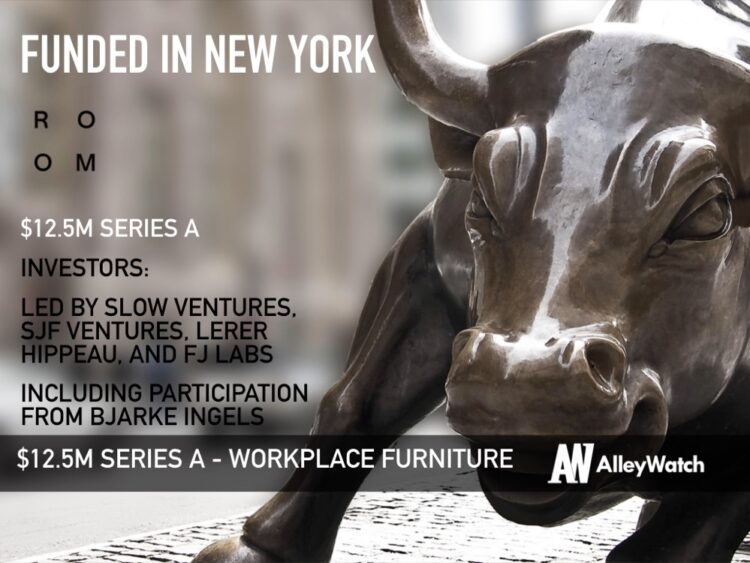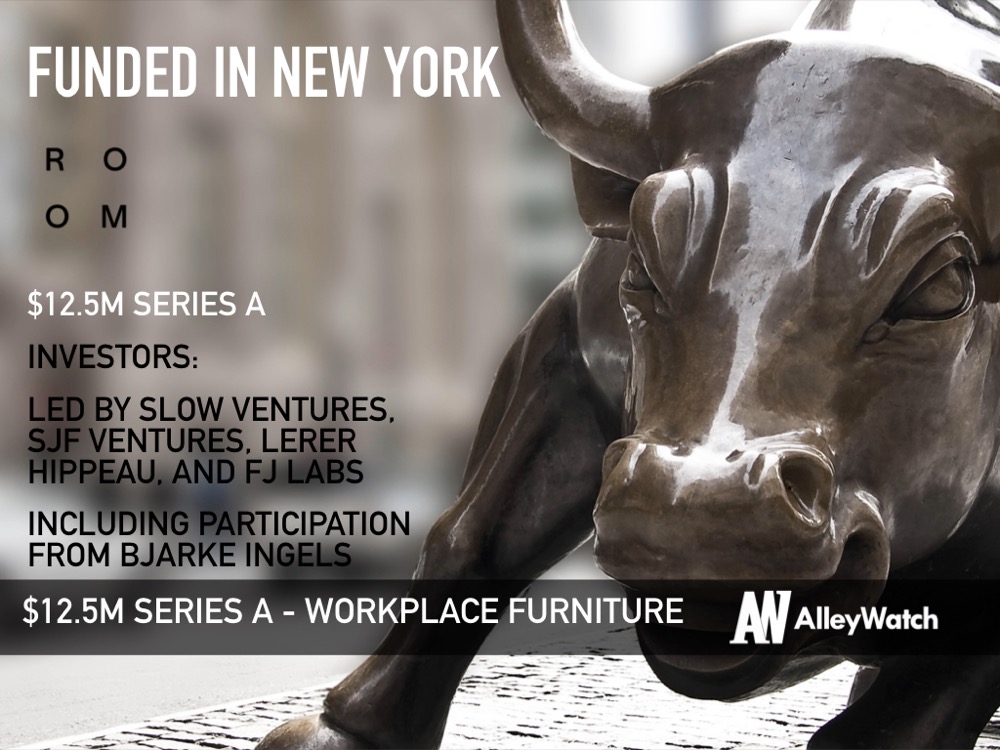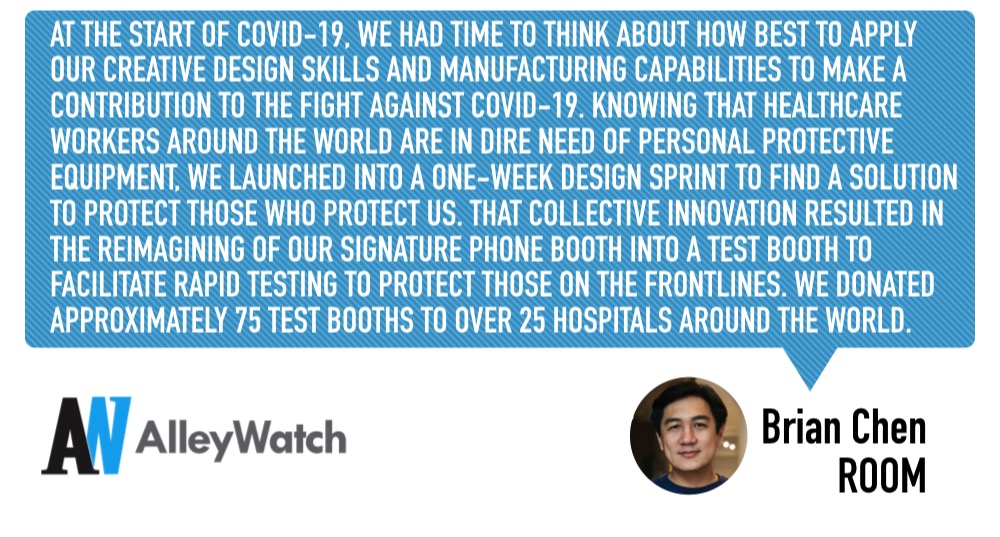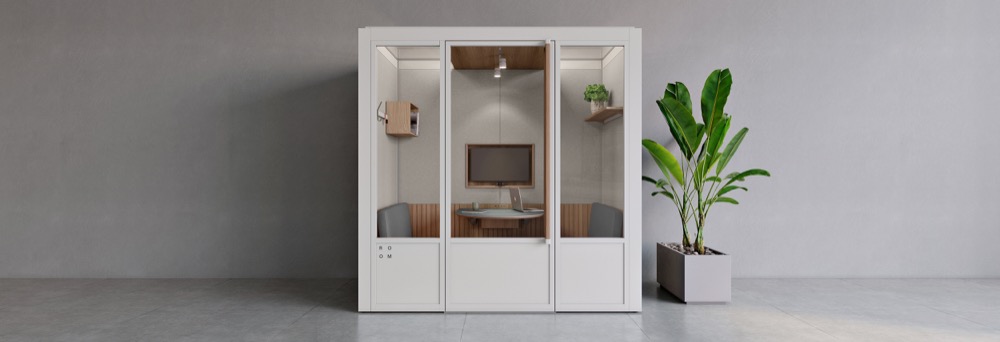After launching its award-winning soundproof Phone Booth, ROOM continues to explore new ways to reinvent the workplace and make certain the needs of today’s modern office workers are met. The company, founded in 2018, is in the midst of preparing for the launch of three new solutions designed for focused work and collaboration. The flexibility and ease of use, coupled with significant cost savings versus construction, are the hallmark features of any ROOM modular solution. This adaptability was evident in ROOM’s COVID-19 response when it transformed its signature Phone Booth into testing booths to help facilitate rapid and safe COVID testing. Aware of its environmental footprint, ROOM recently joined Flexport’s Carbon Offset Program to ensure that ROOM is carbon neutral by offsetting 100% of its global logistics CO2 emissions. ROOM is already used by over 3K businesses and clients include companies like Nike, Google, and Salesforce.
AlleyWatch caught up with CEO and Cofounder Brian Chen the state of workplaces in a post-COVID world, the company’s product pipeline, and recent funding round, which brings the total funding raised to $14.5M across three rounds.
Who were your investors and how much did you raise?
We raised a $12.5M Series A round led by Slow Ventures. SJF Ventures, Lerer Hippeau, and FJ Labs participated in the round alongside world-renowned architect Bjarke Ingels, founder and creative partner of Bjarke Ingels Group (BIG). In addition, Dave Kirkpatrick from SJF Ventures has joined the company’s board of directors, and Bjarke Ingels has been named to our advisory board.
 Tell us about the product or service that ROOM offers.
Tell us about the product or service that ROOM offers.
ROOM is reshaping the modern workplace with modular and creative architectural office solutions. We became the first to solve the problem of noise at scale with the introduction of our inaugural product, an award-winning, soundproof Phone Booth that is easy to assemble and move around. Later this month we will launch three new modular solutions that are purpose-built for focused work and collaboration. Our new product portfolio is priced to be a fraction of the cost of construction, flexible to any environment, and easy to assemble and disassemble as company and employee needs change.
What inspired the start of ROOM?
My cofounder, Morten, and I launched ROOM largely as a result of the personal paint points we experienced while working in various open offices. We were frustrated with having to find a private space to take calls or speak to colleagues, or even just somewhere quiet to work. As we began to research solutions, we saw countless studies showing that open floor plans inhibit productivity and health. It was obvious that the needs of people were being ignored in favor of the demands imposed by real estate. There was a clear gap in the market for a brand that truly resonated with the modern workforce, put people first, and promoted a healthy work environment.
So, we set out to fix this by building a cost-effective solution that would provide space for privacy and focused work without having to revert to the old days of cubicles and corner offices. The result was our inaugural product, an award-winning, soundproof phone booth that is flexible and easy to move around. The success of the Phone Booth has propelled us towards a conversation around the core of what people need from their offices and how we can fundamentally improve the spaces in which millions of people around the world work.
How is ROOM different?
At ROOM, we always start with the end-user in mind, not the facilities manager or the furniture dealer, and we are constantly looking for ways to inspire a better way of working for the end-user. Our vision is to replace expensive and wasteful construction with simple, functional design that fits into any space and doesn’t compromise on quality. Our phone booths ship flat directly to businesses, take less than an hour to assemble, and can be easily disassembled if you need to move them around. This flexibility enables businesses to easily adapt their workspaces as their needs change over time.
Additionally, sustainability is at the heart of everything that we do. From design and manufacturing to final delivery and end-user experience, we’ve thought about sustainability every step of the way. Each one of our flagship phone booths uses soundproofing materials made out of 1,088 recycled plastic bottles. At the start of 2020, we joined Flexport’s Carbon Offset Program in partnership with Carbonfund.org, which allows us to be carbon neutral by offsetting 100% of our global logistics CO2 emissions.
What market does ROOM target and how big is it?
ROOM is building the workplace of tomorrow, and we expect our products to eventually touch the lives of all knowledge workers around the world. To date, we have already acquired over 3,000 unique business customers ranging from budding startups to Fortune 500 companies, including Nike, J.P. Morgan, Google, and Salesforce. We work with anyone ranging from facilities managers to heads of CRE, architects, and designers.
What’s your business model?
Our product development is focused on the experience of the end-user, but our sales model is channel-agnostic. We typically sell direct from factory to business, but we are committed to positioning our product where customers want to buy even if that means a channel partner.
How has COVID-19 impacted the business?
As a business that creates modular architecture for the office, it has been an unusual time for us. At the start of COVID-19, we had time to think about how best to apply our creative design skills and manufacturing capabilities to make a contribution to the fight against COVID-19. Knowing that healthcare workers around the world are in dire need of personal protective equipment, we launched into a one-week design sprint to find a solution to protect those who protect us. That collective innovation resulted in the reimagining of our signature Phone Booth into a Test Booth to facilitate rapid testing to protect those on the frontlines. We donated approximately 75 Test Booths to over 25 hospitals around the world.
Now, we’re planning for the future. COVID-19 has undoubtedly changed the way companies will think about office design moving forward – offices are currently scrambling to find solutions that accommodate virtual collaboration, enforce social distancing, and allow for quick configurability as the needs of employees change quickly. At ROOM, we’ve always believed in a future that’s flexible. Our new modular, purpose-built spaces will give businesses the tools they need to create an agile, productive, and inspiring work environment for all.
What was the funding process like?
Putting yourself in front of world-class investors is a privilege, and the ideal outcome is to come away from every conversation with a more refined pitch, a more nuanced understanding of the market opportunity. That doesn’t always happen, and that is usually a sign that you haven’t found the right investor. The investors in our round all asked incisive questions, pushed us to think bigger, and shared conviction in our vision for the future of workspaces.
What are the biggest challenges that you faced while raising capital?
Private markets can be very fickle when it comes to industry preferences and trends. It can be challenging to find strong, lasting conviction from investors when VC judgment feels so fickle based on the flavor of the day, but ultimately, this is what makes finding the right capital partner so rewarding
What factors about your business led your investors to write the check?
Our investors believe in our vision for an adaptive future – one in which data-driven, modular build-out replaces fixed construction – and understand the increased relevance of our vision in light of the pressures that the global pandemic places on offices. We’re helping companies define their strategies for returning to work and are leading the way for businesses looking to redesign their workspaces to be configurable, flexible, and healthy for employees.
What are the milestones you plan to achieve in the next six months?
Now, as our working lives have been indefinitely transformed by COVID-19, we’re at a point where everyone is rushing to figure out how we can better design the workplace. All of a sudden, people are realizing that we need to have flexible workspaces that can adapt to rapid change.
Over the next six months, we’re excited to roll out new modular large-format products designed for focused work and private one-on-one’s, as well as larger connects, collaborative discussions, and video-conferencing. We hope that we can help businesses safely return to their offices and inspire a better way to work through affordable, sustainable, and flexible solutions.
What advice can you offer companies in New York that do not have a fresh injection of capital in the bank?
I generally agree with the statement that the companies that survive the next 18-24 months will be the ones to dominate the remainder of the decade. So, do everything you can to ensure your survival.
I generally agree with the statement that the companies that survive the next 18-24 months will be the ones to dominate the remainder of the decade. So, do everything you can to ensure your survival.
Where do you see the company going now over the near term?
As companies begin to return to the office, employees will need a multitude of environments to work from. There will likely be a lot of people who prefer to continue working outside of the office – be it at home, or from their local coffee shop, etc. – so companies will have an added responsibility to make the office more aspirational, more inviting, and psychologically comfortable. Offices should be designed purposefully with adaptive architecture that is flexible to move around and can adapt as company and employee needs change.
ROOM’s long-term goal is to offer solutions that create room for people and empower the worker in the modern workspace. What we’ve brought to market is the ‘privacy in an open office’ concept, and this concept extends way beyond the phone booth so there’s certainly more to come.
What’s your favorite outdoor dining restaurant in NYC
I walked by Carbone the other day and was surprised to get an outdoor table without a reservation. Impossible to “walk-in” during normal times!
You are seconds away from signing up for the hottest list in New York Tech! Join the millions and keep up with the stories shaping entrepreneurship. Sign up today






